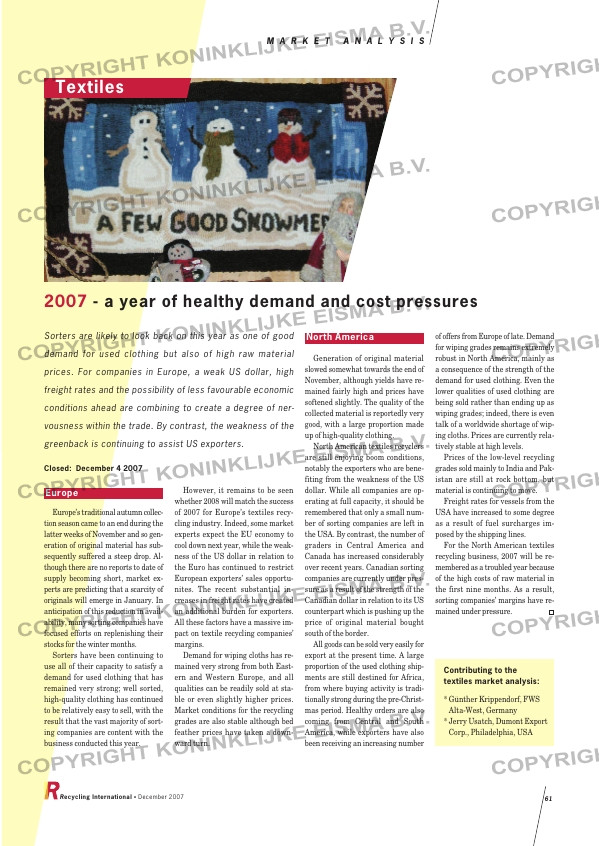Page 61 from: December 2007

M A R K E T A N A L Y S I S
Europe
Europe’s traditional autumn collec-
tion season came to an end during the
latter weeks of November and so gen-
eration of original material has sub-
sequently suffered a steep drop. Al-
though there are no reports to date of
supply becoming short, market ex-
perts are predicting that a scarcity of
originals will emerge in January. In
anticipation of this reduction in avail-
ability, many sorting companies have
focused efforts on replenishing their
stocks for the winter months.
Sorters have been continuing to
use all of their capacity to satisfy a
demand for used clothing that has
remained very strong; well sorted,
high-quality clothing has continued
to be relatively easy to sell, with the
result that the vast majority of sort-
ing companies are content with the
business conducted this year.
However, it remains to be seen
whether 2008 will match the success
of 2007 for Europe’s textiles recy-
cling industry. Indeed, some market
experts expect the EU economy to
cool down next year, while the weak-
ness of the US dollar in relation to
the Euro has continued to restrict
European exporters’ sales opportu-
nites. The recent substantial in-
creases in freight rates have created
an additional burden for exporters.
All these factors have a massive im-
pact on textile recycling companies’
margins.
Demand for wiping cloths has re-
mained very strong from both East-
ern and Western Europe, and all
qualities can be readily sold at sta-
ble or even slightly higher prices.
Market conditions for the recycling
grades are also stable although bed
feather prices have taken a down-
ward turn.
North America
Generation of original material
slowed somewhat towards the end of
November, although yields have re-
mained fairly high and prices have
softened slightly. The quality of the
collected material is reportedly very
good, with a large proportion made
up of high-quality clothing.
North American textiles recyclers
are still enjoying boom conditions,
notably the exporters who are bene-
fiting from the weakness of the US
dollar. While all companies are op-
erating at full capacity, it should be
remembered that only a small num-
ber of sorting companies are left in
the USA. By contrast, the number of
graders in Central America and
Canada has increased considerably
over recent years. Canadian sorting
companies are currently under pres-
sure as a result of the strength of the
Canadian dollar in relation to its US
counterpart which is pushing up the
price of original material bought
south of the border.
All goods can be sold very easily for
export at the present time. A large
proportion of the used clothing ship-
ments are still destined for Africa,
from where buying activity is tradi-
tionally strong during the pre-Christ-
mas period. Healthy orders are also
coming from Central and South
America, while exporters have also
been receiving an increasing number
of offers from Europe of late. Demand
for wiping grades remains extremely
robust in North America, mainly as
a consequence of the strength of the
demand for used clothing. Even the
lower qualities of used clothing are
being sold rather than ending up as
wiping grades; indeed, there is even
talk of a worldwide shortage of wip-
ing cloths. Prices are currently rela-
tively stable at high levels.
Prices of the low-level recycling
grades sold mainly to India and Pak-
istan are still at rock bottom, but
material is continuing to move.
Freight rates for vessels from the
USA have increased to some degree
as a result of fuel surcharges im-
posed by the shipping lines.
For the North American textiles
recycling business, 2007 will be re-
membered as a troubled year because
of the high costs of raw material in
the first nine months. As a result,
sorting companies’ margins have re-
mained under pressure.
Contributing to the
textiles market analysis:
* Günther Krippendorf, FWS
Alta-West, Germany
* Jerry Usatch, Dumont Export
Corp., Philadelphia, USA
Sorters are likely to look back on this year as one of good
demand for used clothing but also of high raw material
prices. For companies in Europe, a weak US dollar, high
freight rates and the possibility of less favourable economic
conditions ahead are combining to create a degree of ner-
vousness within the trade. By contrast, the weakness of the
greenback is continuing to assist US exporters.
Closed: December 4 2007
Recycling International • December 2007 61
Textiles
2007 – a year of healthy demand and cost pressures
RI_031 MA Textiles:MA Textiles 06-12-2007 14:53 Pagina 61



